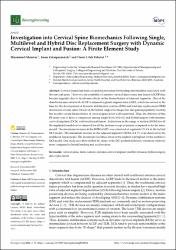| dc.contributor.author | Mumtaz, Muzammil | |
| dc.contributor.author | Zafarparandeh, Iman | |
| dc.contributor.author | Erbulut, Deniz Ufuk | |
| dc.date.accessioned | 2022-01-14T10:54:56Z | |
| dc.date.available | 2022-01-14T10:54:56Z | |
| dc.date.issued | 2022 | en_US |
| dc.identifier.citation | Mumtaz, M., Zafarparandeh, I. ve Erbulut, D. U. (2022). Investigation into cervical spine biomechanics following single, multilevel and hybrid disc replacement surgery with dynamic cervical implant and fusion: A finite element study. Bioengineering, 9(1). https://doi.org/10.3390/bioengineering9010016 | en_US |
| dc.identifier.issn | 2306-5354 | |
| dc.identifier.uri | https://doi.org/10.3390/bioengineering9010016 | |
| dc.identifier.uri | https://hdl.handle.net/20.500.12511/8808 | |
| dc.description.abstract | Cervical fusion has been a standard procedure for treating abnormalities associated with the cervical spine. However, the reliability of anterior cervical discectomy and fusion (ACDF) has become arguable due to its adverse effects on the biomechanics of adjacent segments. One of the drawbacks associated with ACDF is adjacent segment degeneration (ASD), which has served as the base for the development of dynamic stabilization systems (DSS) and total disc replacement (TDR) devices for cervical spine. However, the hybrid surgical technique has also gained popularity recently, but its effect on the biomechanics of cervical spine is not well researched. Thus, the objective of this FE study was to draw a comparison among single-level, bi-level, and hybrid surgery with dynamic cervical implants (DCIs) with traditional fusion. Reductions in the range of motion (ROM) for all the implanted models were observed for all the motions except extension, compared to for the intact model. The maximum increase in the ROM of 42% was observed at segments C5–C6 in the hybrid DCI model. The maximum increase in the adjacent segment’s ROM of 8.7% was observed in the multilevel fusion model. The maximum von Mises stress in the implant was highest for the multilevel DCI model. Our study also showed that the shape of the DCI permitted flexion/extension relatively more compared to lateral bending and axial rotation. | en_US |
| dc.language.iso | eng | en_US |
| dc.publisher | Multidisciplinary Digital Publishing Institute (MDPI) | en_US |
| dc.rights | info:eu-repo/semantics/openAccess | en_US |
| dc.rights | Attribution 4.0 International | * |
| dc.rights.uri | https://creativecommons.org/licenses/by/4.0/ | * |
| dc.subject | Cervical Spine | en_US |
| dc.subject | Disc Replacement | en_US |
| dc.subject | Dynamic Cervical Implant | en_US |
| dc.subject | Finite Element | en_US |
| dc.subject | Hybrid Surgery | en_US |
| dc.subject | Multilevel Fusion | en_US |
| dc.title | Investigation into cervical spine biomechanics following single, multilevel and hybrid disc replacement surgery with dynamic cervical implant and fusion: A finite element study | en_US |
| dc.type | article | en_US |
| dc.relation.ispartof | Bioengineering | en_US |
| dc.department | İstanbul Medipol Üniversitesi, Mühendislik ve Doğa Bilimleri Fakültesi, Biyomedikal Mühendisliği Bölümü | en_US |
| dc.identifier.volume | 9 | en_US |
| dc.identifier.issue | 1 | en_US |
| dc.relation.publicationcategory | Makale - Uluslararası Hakemli Dergi - Kurum Öğretim Elemanı | en_US |
| dc.identifier.doi | 10.3390/bioengineering9010016 | en_US |
| dc.identifier.scopusquality | Q2 | en_US |



















